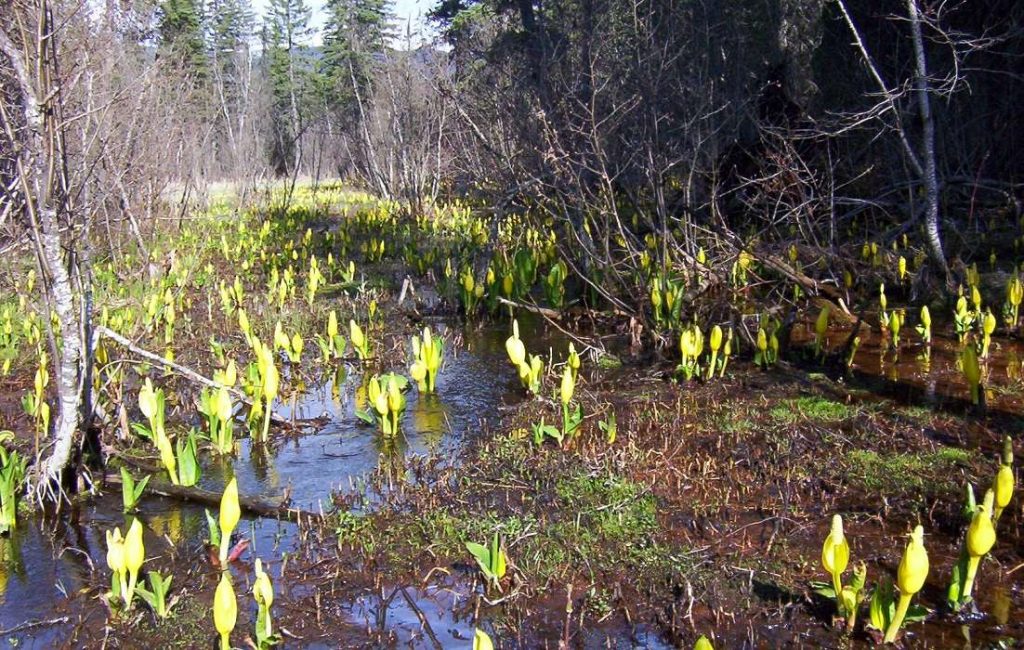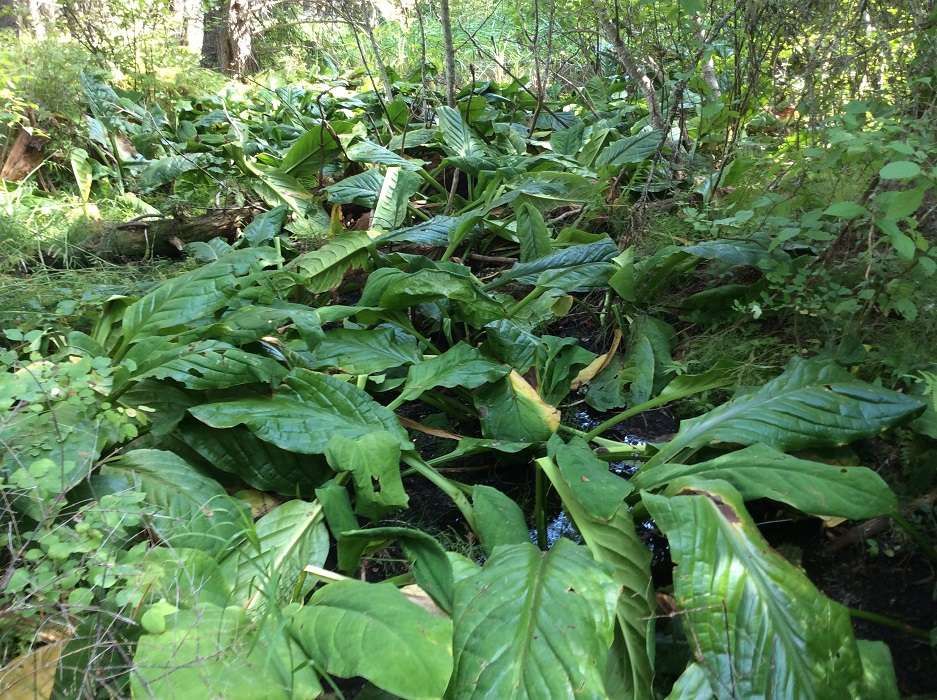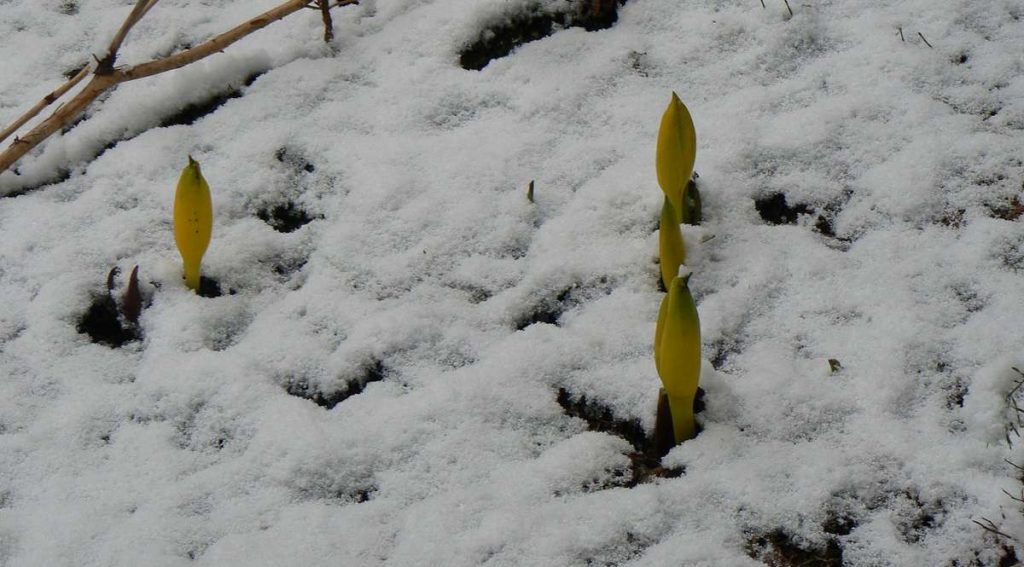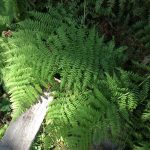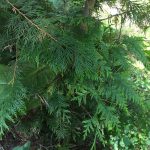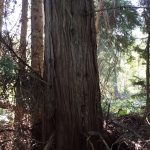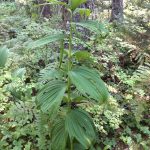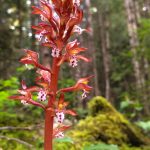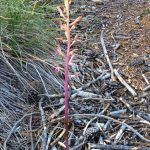A northwest rainforest in Western Montana? How can this be?
Scientist have noticed that parts of western Montana and northern Idaho look like chunks of northwest rainforest from the Pacific Coast that have been plucked and plopped 350 miles inland. One such chunk is a short distance from Smoky Bear Ranch and very easy to access. Plants like Western Red Cedar, Western Hemlock, and Skunk Cabbage which exist in Olympic National Park west of Seattle also exist in these unique ecosystems in Western Montana. Scientists have identified many flora and fauna species that live in both places.
So how did this happen?
The earth’s crust is made up of plates that fit together. These plates move slowly and collide and buckle either over or under each other and sometimes will push upward to form mountains. Between 65 and 90 million years ago, the Farallon Plate slid under the North American plate to form the Rocky Mountains. When this happened, northern Idaho and western Montana were the west coast, and today’s Oregon and Washington were continental islands floating on their own plates in the Pacific Ocean.
These continental islands drifted eastward over the next 10 million years and stacked up against the existing west coast to form the new Pacific Coast. Moist air masses from the Pacific Ocean dropped rain across this region which created a huge rainforest all the way to the Rocky Mountains. The dinosaurs had long since disappeared but other flora and fauna like salamanders, toads, frogs, slugs, aquatic insects, and water plants continued to exist. These flora and fauna are considered to be species found in the Pacific Coast rainforests, but they also continue to exist in isolated ecosystems in western Montana and northern Idaho.
Geological events created this giant rain forest but they also destroyed most of it. Lava flows from Oregon flowed east covering a large area of the rainforest in eastern Oregon and central Idaho with molten rock. About 5 million years ago, the Cascade Mountains of Oregon and Washington formed. These mountains caused the air masses coming in off the Puget Sound to condense and fall as rain on the west side of these mountains causing a “rain shadow” on the east side. This lack of rain in the “rain shadow” area caused the rainforest to dry up and turn into the dry scrub-land and prairie that it is today.
The air masses gained moisture as they passed over the dry lands of eastern Oregon and Washington. As these air masses reached northern Idaho and western Montana, they retained enough moisture to produce the precipitation needed to support the thirsty rainforest flora and fauna. This was the pattern for the next several million years. Then about 2 millions years ago the climate changed again.
Along came the Pleistocene Epoch, a 2 million year ice age which cooled the entire planet. Even though the average temperature was only a few degrees cooler than those of today, snow piled up high and created great slabs of ice covering Canada and the Rockies. These glaciers formed present day Montana and whittled the peaks of the Rockies. Some of these glaciers were up to 1 mile thick and covered the inland rainforests in northern Idaho and western Montana. But some of the southern portions of these rainforests in valleys where the lower elevations created warmer temperatures escaped this glaciation as it was too warm to sustain the thick ice. These rainforest remnants are know as refugia – places which still contain populations of once widespread flora and fauna creating the Glacier National Park Rainforest near us.
Glacier National Park Rainforest
We first became aware of the uniqueness of this Glacier Park Rainforest when a friend from church told us she was going to see the Skunk Cabbage blooming on her mother’s farm, as Skunk Cabbage plants were diminishing in numbers. I mentioned she should come see the Skunk Cabbage patch near us. When she saw it she was just amazed. A few years later when the Forest Service was surveying their property line, the employees had never seen anything like this ecosystem before. We’d tell local people about this nearby rainforest and they all thought we were crazy. Then in April 2011, Montana Outdoors published an article titled “The Land That Time Forgot” and after reading it we realized it described exactly the ecosystem of the Glacier National Park Rainforest near us.
Scientists have discovered about 150 species of flora and fauna plus many more insects existing in both the rainforests of the Pacific Coast and this Glacier National Park Rainforest. Two of the most noticeable plants in this nearby rainforest are Skunk Cabbage and Lady Fern.
Skunk Cabbage
Skunk Cabbage like to live in low-elevation swamps or bogs of moist montane forests. In our nearby Rainforest, they bloom in late April to early May generally when there is still snow on the ground. They have the unusual ability to warm themselves thus melting the snow around them. The bloom is a bright yellow bract cupped around a pod of tiny yellow flowers. This plant gets it’s name from the odor it emits while it’s blooming, or if you accidentally step on one of the leaves. Once the leaves start to emerge
from the wet earth, the yellow bract dries up and the flowering pod turns green. The leaves grow very quickly and become the dominant feature of the plant. They are unusually large, up to 60” long and 18” wide, and are referred to as “elephant’s ears”. The plant is said to be edible when properly fully cooked. If not cooked properly, when eaten these plants may impair kidney function and can be potentially fatal.
Lady Fern
You will find the Lady Fern growing in the same swamps and bogs along with the Skunk Cabbage. They can grow up to 3 feet high and 2½ feet wide. Their foliage is feathery and finely textured and they like shady to partly sunny areas. They get their name because of how their reproductive structures are concealed in an inconspicuous manner. The rhizomes and young fronds are poisonous when raw, but edible after cooking.
Western Red Cedar
Western Red Cedars thrive very well amongst the other pine trees in our treasured Glacier Park rainforest.
They have a scale like foliage with reddish-brown bark that is vertically ridged. The very light wood is straight grained and resistant to decay. The cones are up to 3/4” in length and have cone-scales with sharp points near the tip. Western Red Cedars can have a very long life span – 800+ years. Several of the 100+ year old lodges in Glacier National Park were made with Western Red Cedars logs, which still have the bark on them.
Green False Hellebore
Another swamp loving plant is the Green False Hellebore. You can find them living right with the Lady Fern and Skunk Cabbage in the swamps of this nearby Glacier National Park Rainforest. They grow up to 6 feet tall with green flowers. The flowers are arranged on several branches at the end of the main stem. The leaves are very distinct as they are pleated with fan like folds up to 12” long and 6” wide. These plants are very poisonous and can cause severe sickness and death if ingested.
Spotted Coralroot
A rare species in this Glacier Park Rainforest is the Spotted Coralroot. This plant is a member of the orchid family and has no green leaves. The Spotted Coralroot requires a moist forest environment and is becoming increasingly rare as these habitats are slowly being destroyed.
Because it lacks chlorophyll, the Spotted Coralroot does not produce food by photosynthesis but rather through a complex relationship with soil fungi. They are reddish purple to brownish, up to 15 inches tall, and adorn 10-30 dainty flowers on the top 1/3 of the stem. It gets it’s name from the purple spots on the white, broad, showy petal.
So when you stay at Smoky Bear Ranch, ask about a visit to the rainforest, we’d love to show you how to get there or even give you a personal tour through this unique ecosystem. But watch as you navigate the ladder style bridges that you don’t step on one of the frogs sunning itself.
If you are a plant expert, we’d love for you to help us identify some of the other 150 or so species of plant life.


